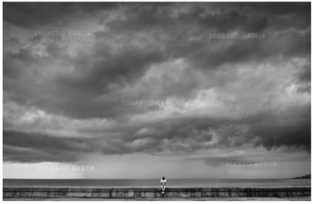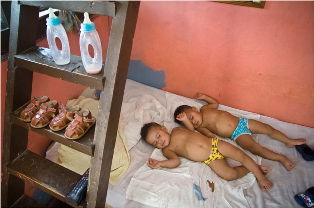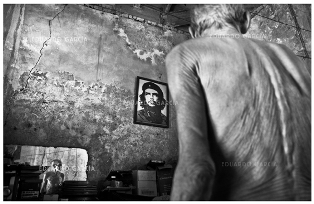Capturing the True Color of Havana
Interview with Cuban photographer Eduardo Garcia
By Yanelys Nuñez Leyva

HAVANA TIMES — Amid the commotion of the new year, when everyone was celebrating with music and the arrival of 2013, I had the opportunity to interview Eduardo Garcia, the winner of the most recent Havana Times photo contest in category of “Uniforms.”
His work “Un equipo de verdad” (“A Real Team,” the shot that earned him the award) was taken at the Latin American Stadium, located here in Havana. With it, Eduardo gave us a taste of what real talent and wealth Cuban life can produce, photographically speaking.
As a young father who prefers photography to interacting directly with people, Eduardo is one of those empirical creators who spend their energy and passion in what they do.
His work as a photographer has earned him awards such as first place in the Sixth Digital Art Exhibition, in 2004. Those photos were produced in conjunction with his brother, Orlando, who’s also an up and coming photographer.
Although he ventured into this medium of expression only three years ago, Eduardo has discovered that “searching for the human being is in [his] nature*.
Havana Times: How did you get into photography?
Eduardo Garcia: I graduated from the English Language Teaching Program, but I always liked art. That’s why, when I was still a student at the university, I enrolled in the Antonio Diaz Pelaez School. There they taught drawing, painting, sculpture and art history, though I wasn’t able to graduate from there because of the time requirement. Still, those classes provided me some basic tools.

During that same period I stumbled onto photography, and I also participated in a community project organized by Cecilio Aviles, which is still being carried out along the Prado esplanade. It was there that my brother and I met some photographers. Among those who stood out were “Chang,” who introduced us to Raul Cañibano, an important Cuban photographer. The snapshots that we were taking back then were digitally manipulated works. An example of this is the series entitled Angeles en La Habana.
HT: What did it consist of?
EG: That series was a vehicle for displaying our city in a more poetic fashion. The photographs in it were turned sepia, making them look aged. In them we included shots taken in other times by photographers from Great Britain (such as Julia Margaret Cameron), the USA, Germany and of any other nationality. Our intention was to create a story that interwove people of the past with those of the present. Something that supported the idea was how these shots came out in the end – they had a strong feel of being time-forgotten.
This way of producing images changed dramatically when we met Chang and the other photographers. We began to appreciate the work of other national and international artists, ones like Brassai, Cartier-Bresson and others who did very interesting work. However, as we carried this out, we were tempered by the marked interest that we felt for the human being as a subject. That is our main motivation, and in photography we’re able to find the best means of speaking about them.

EG: Photographic composition involves principles that are similar to painting. This is something that helped me a little. When I would go out to take photos with Chang or Cañibano, I would hardly take any pictures since I didn’t know what to do. So I stopped to observe how they moved in the terrain. That’s when I started to understand when to wait, when to approach, when to duck down and when to back up. What was important about these experiences was that I realized that photography requires exercise. The more you practice, the better you get in the situations that present themselves in front of your lens.
HT: The series Similares Diferentes(exhibited at the Fototeca de Cuba in 2012) was a joint project with your brother Orlando, who has shared other work experience with you. Why did you select the topic of twins?
EG: Well, that theme is very close to us by virtue of us being twins. Investigating the matter with some photographers, we found out that nothing like this had ever been done before. This is a project that hasn’t concluded, and I think that it will last my lifetime. I only wish we had the opportunity to travel to all the provinces in our country in search of other such people.
The aim of this series is to show twins in their daily lives. We want to express the similarities that unite them, but also show the particularities that differentiate them and identify each of them as individuals. My relationship with my twin brother is very intense, sometimes I think much more than other siblings might have. So this is a subject that attracts me.

EG: This partnership began in 2004 when we won the Digital Art Award. After that, we started doing art projects of a different nature, not only the ones we choose but also ones by request. This is how we wound up doing general videos, commercial videos, video art, posters and installations. In many cases we took advantage of the tools afforded by new technologies. These are tools that I have tried to master over time with the help of my brother, though he has more comprehensive training in them since he graduated from ISDI (the Institute of Industrial Design).
Currently, the photography that we’re realizing in our particular manner absorbs a lot of our time. Our joint project hasn’t stopped, whenever there’s an idea that excites us and that we want to develop, we continue working together.
HT: What works stand out?
EG: I can mention, for example, a promotional video that we did in 2008. It was specifically directed at young artists immersed in a cultural project that aimed to make more visible the work of some new emerging artists at the time. The project was run by Norman Bardavid Nissim, a Mexican art gallery operator.
Another work was the video realized for the Eduardo Abela exhibit titled “Mecanica Popular” (Popular Mechanic). There was also the 13th Erotic Art Exhibition, where we presented “La Preferencia” (The Preference), which is an interactive installation for which we won first prize.

EG: Currently I’m working on several series in parallel. One of them, about the Malecon boardwalk, had its origin in a project between Cañibano, Chang and me that fizzled out. We were going to call it “Bleco,” the name that some people use to identify the Havana’s Malecon seawall. When I refer to the images I’ve captured in this space, I group them under the heading “El Borde” (The Edge), but I haven’t decided whether to keep that name or not. I’d like to find a concept that reveals the true essence of that place.
Another series is “From Inside,” with which we’re hoping to make a book for displaying my photographs in and about this city. It would also show my brother’s work from out in the countryside, since he lives and works in Ciego de Avila.
I’m also in process of putting together a series that I started in late 2011 that addresses the issue of baseball. My biggest concern with these images isn’t to immortalize the work of prominent athletes, as has already been done and is being done by well-known photojournalists, but to capture the dynamics that can be seen in the stands, interacting with the public.
HT: What about religious themes?
EG: Well, I took some pictures at the El Rincon sanctuary, but it’s not my interest to construct a series with them; there are excellent photographers such as Cañibano who have very complete collections about this religious setting. The times I’ve attended the ceremonies — which takes place on the eve of December 17 (San Lazaro or Babalu Aye Day) in El Rincon — these were to take pictures of an event that has acquired such socio-cultural resonance today.
HT: Aren’t you interested in digging more deeply into that theme?
EG: Yes, very much so. Recently my brother and I presented a project for an arts creation fellowship organized by the Fototeca de Cuba that sought to address that topic. The images that we sent in were taken in El Rincon, as well as in other areas of the island. Our goal, if we win the fellowship, is to carry out work that reflects the nuances of religion in today’s Cuba.
HT: Why do you tend towards documental work and the preference for black and white for your photographs?
EG: The visual richness that daily life possesses is what really catches my attention. The cultural information that we can offer to the texture of a wall or to the shape of a structure or to the appearance of a person’s skin is of incalculable value. Knowing how people act, what moves them, or what their interests are is something that we provide through this kind of work.

With regard to the other aspect of your question, I can say that I see Havana in black and white. Plus, making color photographs is very difficult for me. When I sometimes decide to do them, I look for colors in my compositions that retain relationships with each other, not only with people, and also with the pigments. I like the colors that either contrast or complement each other.
But, like I said, I prefer that kind of grayish hue that has a strong overlap with certain textures. To me, that’s the true color of Havana.
HT: Documentary photography requires that you constantly interact with people. How is this contact produced?
EG: It’s difficult. But I’ve tried to develop an approach to people so they don’t feel uncomfortable. When I think I might cause some discomfort, often I’ll refrain from taking the shot, and in those cases I’ll try to talk and get to know them. That kind of experience greatly enriches you.
HT: How do you see the Cuban photographic movement, and what do you think about the promotional strategies that are taking place around it?
EG: Currently there are a lot of young people immersed in this world of photography. But there is considerable interest for what’s called “conceptual photography,” which is greater than the interest in documentary photography. This is probably because photojournalism still isn’t seen as an art, and everybody wants to be an “artist.” I think it’s not about valuing one approach or the other, because producing striking images in both expressions is complex. It all boils down to selecting the approach with which you feel most comfortable.
In terms of the promotion that should be provided by institutions, I think there exist some settings (though there could always be more) for this activity. What complicates the issue is the funding that a young artist needs when it comes to putting on an individual exhibition.
For those interested in learning more about the photographic work of Eduardo Garcia, he can be reached at his home located at 411 Empedrado (Old Havana), where there are usually a set of snapshots on display that are intended to reflect his various concerns about photography.
—–
* Rephrasing of a line from the novel Rayuela (Hopscotch), by Julio Cortazar





